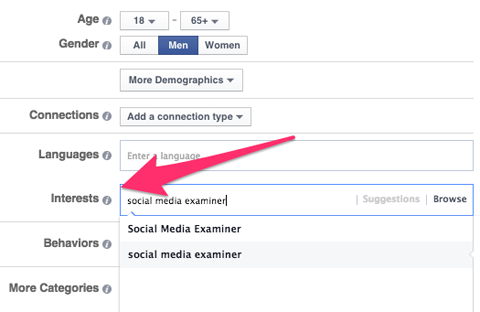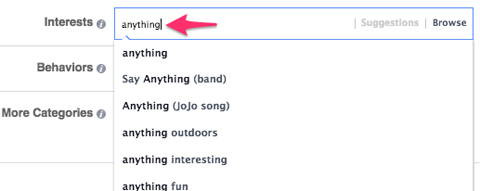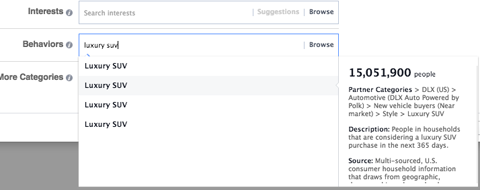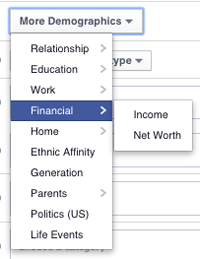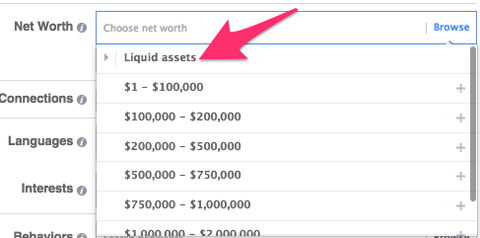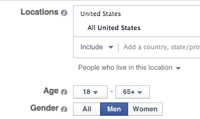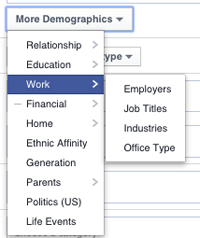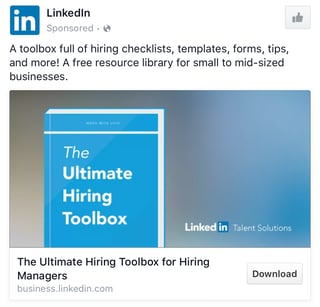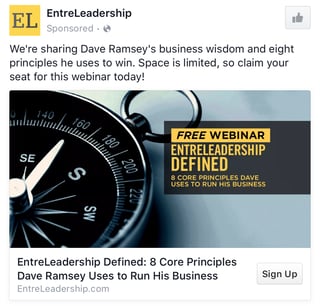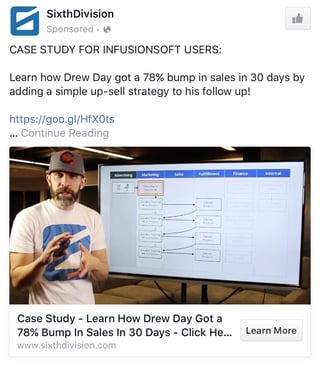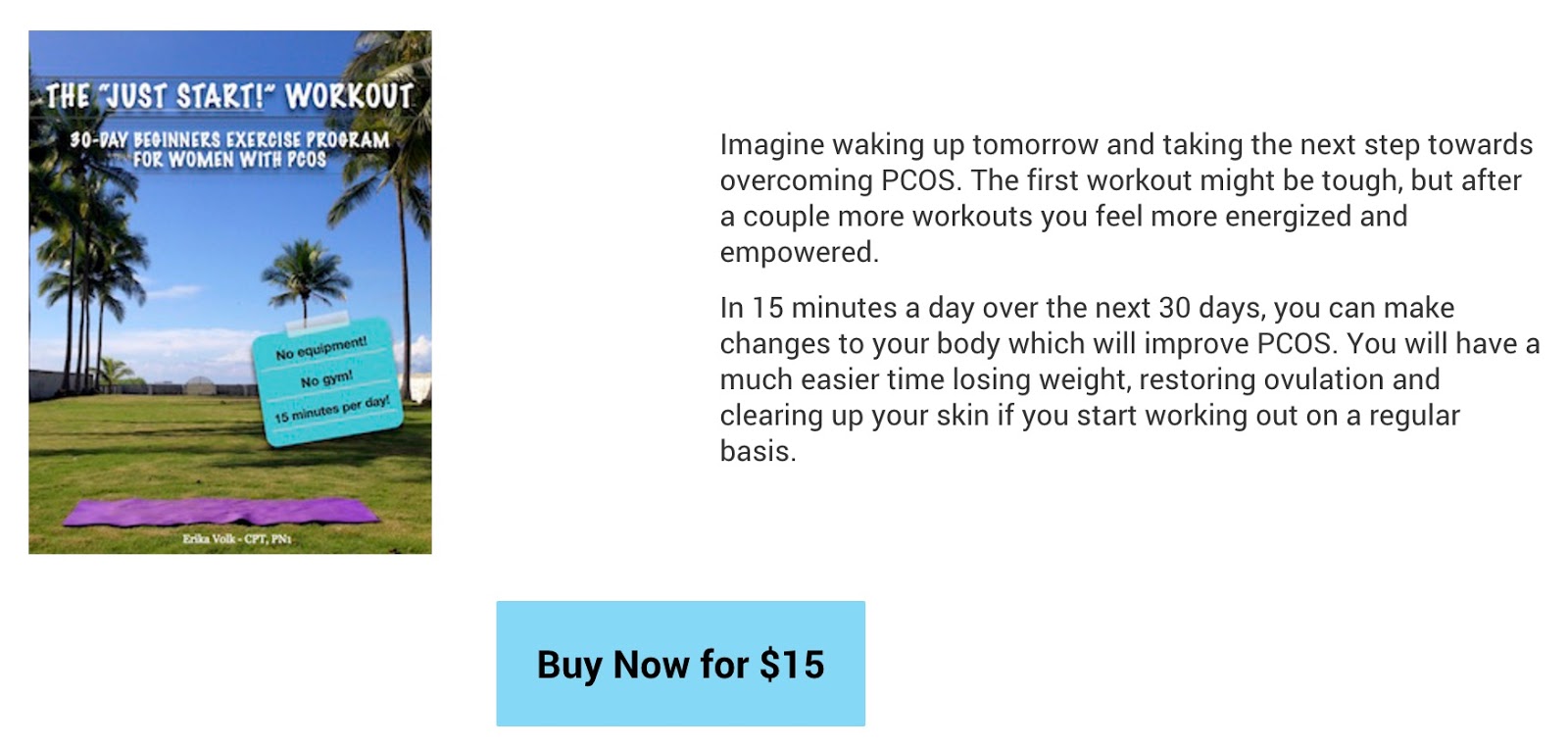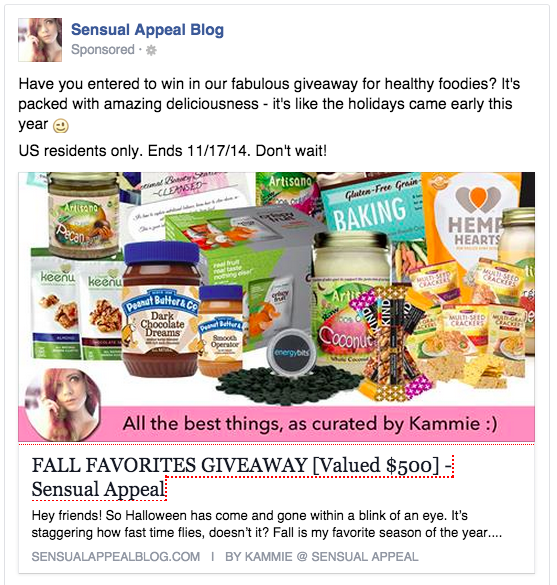Subscribe now and get the latest podcast releases delivered straight to your inbox.
 Facebook has built the most cost-effective advertising platform of our time and it's a shame that more B2B brands aren't capitalizing on it.
Facebook has built the most cost-effective advertising platform of our time and it's a shame that more B2B brands aren't capitalizing on it.
There's been some resistance towards the platform from marketers in the last few years as Facebook requires you to "pay to play," so to speak, but considering how effective and highly-targeted the system is, it's more than worth it.
While Facebook ads are useful for a variety of marketing goals, in this article, we're going to focus on using them to grow your email list.
How to Get More Blog Subscribers with Facebook Ads
You've probably heard that Facebook isn't the best place for B2B marketers to focus their energy, but that's simply not true. When it comes down to it, Facebook is still the most powerful social media platform even for B2B.
More people use Facebook and invest the most time in Facebook than in any other social network.

With all of those users' attention, you can reach a wide audience within your industry.
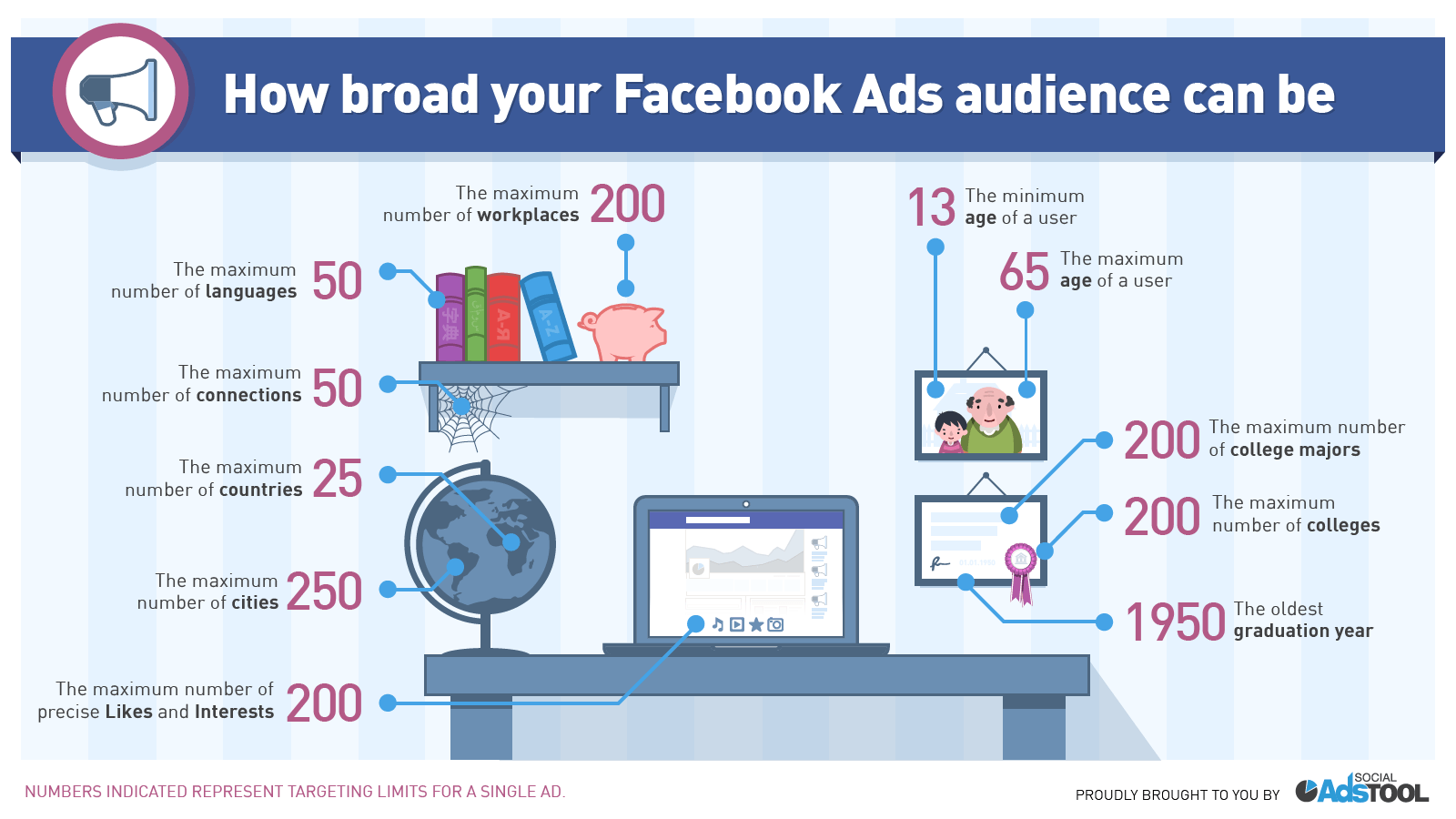
But Facebook Ads can also reach a highly-targeted buyer persona as Neil Patel illustrates in this photo:

Behind every B2B transaction is a human buyer. One who most likely uses Facebook like the rest of us. If there's enough human value (i.e. education, entertainment, etc.) in what you're offering, you can generate leads on any social media platform including Facebook.
Create a Target Audience for Your Ads
Be sure to create a custom audience if you haven't done any previous Facebook advertising.
Below are the five essential ways for B2B marketers to target their audience on Facebook from Social Media Examiner.
#1: Know Your Customers’ Interests
On Facebook, you can target people who have expressed an interest in or like pages related to another page or topic. This is interest-based targeting, although it is commonly confused with “likes” targeting.
There are thousands of interests to target, and they’re located in the Interests section of your ad set settings.
![facebook interests targeting]()
To target interests, go to that section of your ad set settings.
Type literally anything into the search box and Facebook will suggest matching or related interests.
![related interest targeting]()
Type in a specific page, a subject or literally “anything” to get related interest.
Interest targeting usually means that you’re targeting large audiences. So before you set up interest targeting, evaluate the size of your target group. Then consider combining an interest with at least one other targeting method.
#2: Seek Out People in the Market for What You Sell
Our online behavior tells platforms a lot about our buying intentions. By combining data from different sources, Facebook is able to tell who is in the process of buying a given product.
Therefore, you can target people who are looking to buy something specific; for example, new vehicle shoppers in the market for a luxury SUV.
This option is located in the Behavior section of the ad set settings.
![behavior targeting]()
Go to the Behavior section to target people looking to buy a specific product.
You’ll see multiple categories in a scenario like this, because Facebook allows you to be that specific. In the case of the SUV, target people who are looking for a new SUV, a used SUV and so on.
Experiment with this targeting option to determine which methods are most profitable.
#3: Target People Based on Financial Resources
If you want to sell a product or service that is tied to affordability, this method is extremely useful. Listed under Demographics, this targeting option allows you to select among Income, Net Worth, and Liquid Assets.
![income targeting]()
Go to the Financial option under Demographics to target by income and net worth.
Liquid Assets is an option under Net Worth.
![liquid assets targeting]()
The Liquid Assets segment is located under Net Worth.Targeting people by income, net worth, or liquid assets usually works well as a stand-alone option. When businesses combine it with a behavior that best matches their target group, the audiences are often too narrow. The trick is to choose a broader behavior than usual in case the audience turns out to be small (for example 10-20K).
According to Facebook Power Editor, their data is “Modeled based on age, income, presence of children, occupation, property data, vehicle data, investment interest and census median data.”
#4: Combine Age and Gender With Where People Live
Instead of simply targeting geographic areas, add age groups and gender to the mix. For example, target men ages 25-35 who live in New York City.
This is based on the first information people share when they create a Facebook profile: age, gender and city they live in. Targeting people based on where they live can also be a great substitute for targeting certain income levels, because it presumes a certain quality of life.
This method can be used right after setting up an ad set.
![age and gender targeting]()
After you set up an ad set, narrow your target to age, gender and location.
Target virtually any state, region and city in the world (with a few exceptions). Another option is to exclude part of a region to optimize your ads even further.
A few selected countries, such as the United States, also support zip code targeting.
#5: Target People by Industry or Occupation
For products or services that are ideal for people who work in a given industry or have a specific job, use industries or job title for the targeting method. For example, target “Employed in Arts, entertainment, sports and media.”
This is located under Work (below Demographics) on Facebook.
![work targeting]()
For products and services related to a specific field, target by job titles or industries.
The industry people work in can be a great alternative to simply targeting by office type.
![narrow work targeting]()
Narrow this category even more by targeting by office type.
In fact, office type targeting actually allows you to target three more small office categories.
Attracting Blog Subscribers Through Shared Blog Content
One way to start converting blog subscribers from Facebook is to "Boost" a post promoting a recent blog post. This approach allows your content to reach more people and gets prospects on your website, engaging with your content.
This isn't the most effective way to drive conversions, but it's important for the sake of giving your blog content more exposure. The more people engage with the content you boost, the more frequently it will organically appear in user timelines.
Blog subscribers are the secondary benefit -- assuming your content is good.
Leveraging a Lead Magnet to Generate Conversions from Facebook Ads
The most effective way to get more blog subscribers from Facebook is by promoting a lead magnet (or premium offer.)
If you don't already have a lead magnet you'd like to promote on Facebook, read the following excerpt from an AdEspresso blog post to help decide on what kind of lead magnet you are going to create:
A lead magnet is anything that your potential customers will find valuable. You’re going to offer it for free in return for their email and consequently a chance to develop a relationship with them.
Most advertisers automatically think of eBooks while brainstorming for lead magnets. While eBooks are a great lead magnet, they’re also extremely time consuming to write.
A lead magnet does not need to be a 50 page book. It can be as short as a 1 page PDF or an Excel template. As long as it provides value to your users, a less bulky lead magnet can be a great thing.
It will provide immediate gratification to your users
They’ll be immediately ready to move to the next phase of the funnel and become customers
They will take less time and effort on your end to create
Here are some great examples of Lead Magnets you can offer:
eBooks: One of the most classic lead magnet, we use it a lot with our Facebook Ads eBooks and it works great. On the downside they take a long time for the user to read and even longer for us to write.
Articles: Often you don’t need to write a whole book. Offer users a downloadable .pdf version of your top articles for future reference. They’ll love it. Brian Dean at Backlinko use this tactic a lot.
Free Tools: Offer you users a free tool (online or downloadable). This Lead Magnet has a very high perceived value and you can ask more information about the user in return for it. We have successfully used it with Facebook Ads Compass, Hubspot has a free Marketing grader and Neil Patel a Website Analyzer
Checklists/Templates: We’re doing this right on this page with our Checklist for creating a Lead Magnet. It takes little time to create these magnets and they’re valuable for the user to apply what they’ve read. Other examples include excel templates of reports and so on.
Discounts: Widely used by eCommerce websites. Sign up to the newsletter and immediately receive a 10% discount. They can be somehow less performing but they take virtually no time to implement!
Prizes: Contests with prizes are quick to setup, easy to promote and can go viral. Be sure to give away prizes strictly related to your industry, not a Ferrari (unless you sell luxury cars) or you’ll end up with totally useless leads.
Video Training: What I love about video training is that it’s extremely personal. It creates loyalty and a strong connection with your potential customers. The downside is that they are very time consuming and unless you are very good at it, can make you seem an amatuer so practice a lot before creating one.
Quiz & Surveys: Some users love Quizzes & Surveys. We tried this kind of magnet with our Facebook Ads Test. I have to say it was not one of our biggest success. The perceived value is usually pretty low.
Email Courses: This format is just great for repurposing. Have a great post or ebook? Just split it up in 10 parts and offer it as a daily/weekly course on the subject. It’s super easy to create but the downside is the user won’t be ready to move to the next step immediately.
There are so many different Lead Magnets that you can offer! This is an absolutely partial list, the options are only limited by your creativity.
Now that you know some of the options you have, it’s time to better define what the ideal lead magnet looks like. Your ideal lead magnet should:
- address a very specific niche of users
- solve a problem they have
- be extremely easy to consume
- be perceived as highly valuable
The first point is the most important here. Targeting a very specific niche of users or a very specific problem is the key for success.
The more specific you are, the easier it will be to drive traffic to your lead magnet through Facebook Advertising and the higher your conversion rate will be.
Let’s say you want qualified leads about cooking. Recipes are the most obvious lead magnet. Yet, the internet is flooded with recipes. Adding to your site something like “Subscribe to our newsletter and receive our Free Recipes” won’t be so tempting. You’re not addressing a specific problem your users have and you’re not identifying a specific and highly relevant niche to target for Facebook Ads leads generation.
You could instead offer “27 easy vegetarian recipes to eat before a test” Now this is something specific! We have a buyer persona for our lead magnet. Young students who lives away from their families and love vegetarian food!
With such a laser-focused targeting you’ll be able to drive cheap traffic from Facebook Ads and you’ll have a great conversion rate on your landing page!
Once you have your incredibly valuable lead magnet, you'll also want to create a landing page. This is a page you'll direct Facebook users to so they can fill out a form and receive the lead magnet you're offering.
Here is a basic rundown of everything you need to know about creating landing pages that convert, as provided by Neil Patel:
The moment you create a landing page, your mindset will shift towards conversion rate – which is where it needs to be. After all, that’s all that matters once you start attracting Facebook clicks and visitors to your page.
Your landing page should have elements – such as the headline, subtitle, and call to action (CTA) – that can be tested and improved.
Changing your CTA button color or position can have a significant impact on your conversion rate, but it’s just the beginning of building a high-converting landing page. Your page itself needs to be focused on conversions, with persuasive copy that’s relevant to the readers.
According to Instapage, over 1,000 landing pages are designed with their software on a daily basis and this number keeps growing. This illustrates that marketers are embracing landing pages and understand their importance.
The bottom line is this: Whether you’re doing search engine optimization or running a PPC ad with Facebook or Google AdWords, you need a high-converting landing page.
You can’t possibly expect people to convert if you’ve got nothing useful to share with them.
Jayson DeMers said that if you create landing pages properly, you may even enjoy increased SEO benefits, even though your main source of targeted traffic is Facebook.
Hiten Shah, co-founder of KISSmetrics, discussed in his newsletter a few months ago that more marketers are creating landing pages for reasons other than new product features or releases.
A recent study by MarketingSherpa agrees with Hiten’s assertion – 67% of marketers are creating unique landing pages for various marketing campaigns or brands.
When a new product is added, these smart marketers also create a new landing page in order to target a different audience and its specific needs.
When it comes to design, there’s no need to reinvent the wheel. In fact, the landing page where you drive your Facebook clicks should look similar to your typical landing page for running a different type of PPC ad. Instead, focus on the anatomy – the elements that make up the page.
When you come to a well-designed page, you’ll notice the headlines, subtitles, bullet points, and more. They’re all important elements on any meaningful landing page.
Here are three more resources you can use to help create better landing pages:
- How to Write Ridiculously Persuasive Landing Page Content
- 3 Psychologically Proven Ways to Convert More Landing Page Visitors
- 25 Landing Page Design Best Practices You're Neglecting
Examples of B2B Advertising on Facebook
In a recent blog post, 7 Inspiring B2B Facebook Ad Examples, we showed you examples of actual ads that B2B brands are using to generate leads from Facebook.
Below are three of those examples. You can see the rest by clicking here.
1. Linkedin
What to like about this ad:
- Clearly defines who it's for: Small to mid-sized businesses.
- Clearly articulates what you get: A toolbox full of hiring checklists, templates, forms, tips, and more.
- Visual is clear: It's a downloadable piece of content.
- Has a clear call to action: Download.
2. EntreLeadership
What to like about this ad:
- Strong value proposition: We're sharing Dave Ramsey's business wisdom and eight principles he uses to win.
- Has urgency: Space is limited.
- Clearly defines the Offer: It's a webinar.
- Has a clear call to action: Claim your seat for this webinar today > Sign up.
3. SixthDivision
What to like about this ad:
- Very strong value proposition: Learn how Drew Day got a 78% bump in sales in 30 days by adding a simple up-sell strategy to his follow up!
- Creates anticipation: I want to know what that one thing is!
- A real person in the picture adds credibility.
- Has a clear call to action: Learn More.
Also, check out these 20 Clever Facebook Campaign Ideas You Wish You Thought Of First for more inspiration.
Facebook Advertising Case Studies
Now, let's take a look at how other marketers are applying these tactics and strategies to get real results.
"How I Got 5,324 Subscribers for my Blog Using Facebook Ads in Less than 60 Days by ShoutMeLoud"
In this case study, Deepak Kanakaraju used Facebook Ads to promote a free digital marketing course and increase blog subscribers.
Here is the landing page he used to promote his free course:

Take a look at the conversion rate he achieved:
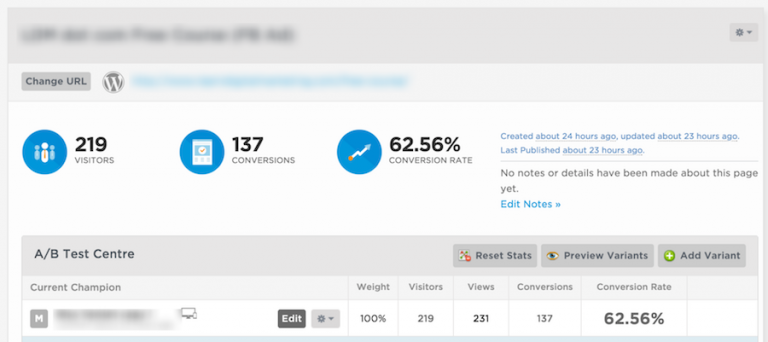
And here is his cost-per-subscriber from this campaign:
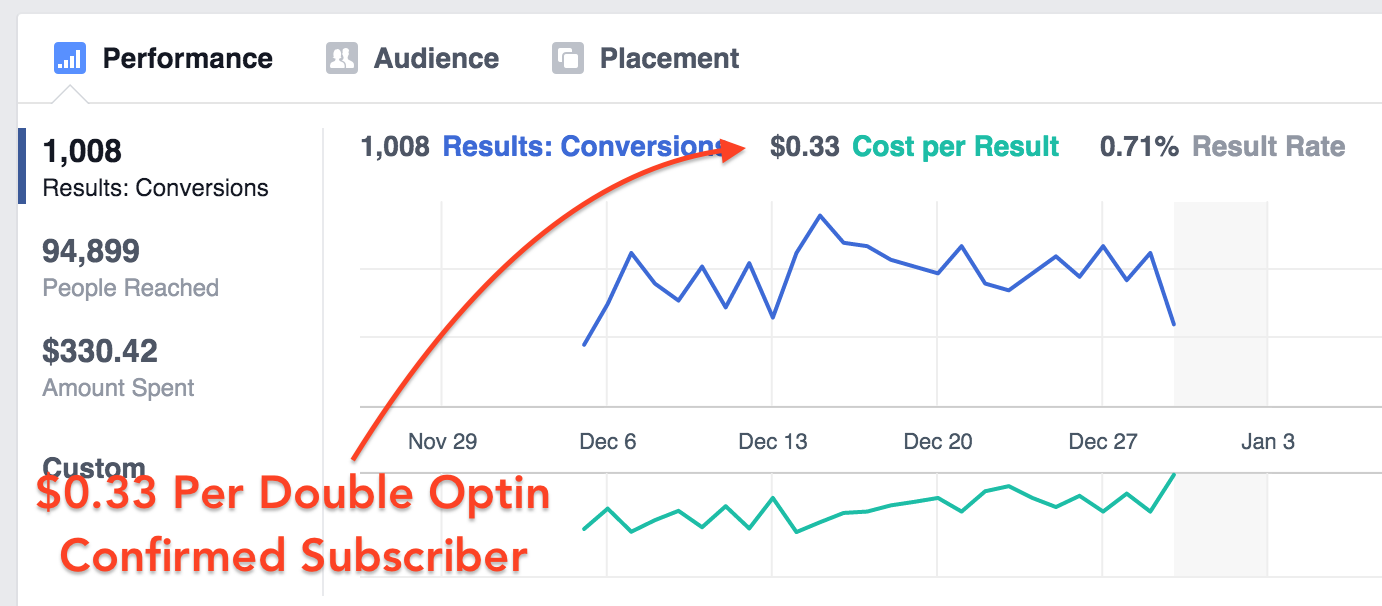
If there was one tactic you could steal from Deepak, it's optimizing your ad for conversions.
"One of the most important things I did with this campaign was that I let Facebook optimize the ad for conversions, not clicks or impressions.
If you are optimizing for impressions, then Facebook will try to show the ad to the maximum number of people irrespective of how many people are responding to your ad. If you Optimize for clicks, Facebook will show your ad to the people who are more likely to click on your ad.
But when you optimize for conversions, Facebook will show the ad to the people who are more likely to convert.
For running such a campaign, Meta Pixel is a must, and I recommend that you have it installed on your website for at least two weeks before you start the campaign.
You will have the option to optimize for conversions when you edit your ad set in the power editor.
However, note that Facebook will only try to optimize for conversions, but the end of the day they will charge you for impressions (CPM).
The trick here is to run the ad for sometime and let Facebook learn and optimize your ad campaign automatically so that it is shown only to the people more likely to convert.
Facebook has so much information about each user on their system and looking at the existing conversions; it can intelligently predict who will convert. That’s the main secret of getting 1%+ conversion ratio from Impressions to Subscribers."
"How This Fitness Site Got 1,892 Hyper Targeted Subscribers with Facebook Ads featured on Grow and Convert"
In this case study, Erika Volk was able to promote her fitness blog, attract nearly 2,000 new subscribers, and realize a positive ROI!
Part of what makes Erika unique is that she was able to overcome PCOS, which is a medical condition that affects women and causes weight gain (among other problems). Her blog focuses on helping other women do the same.
Here is the Facebook ad Erika used:

Here is the landing page that Facebook users were directed to:
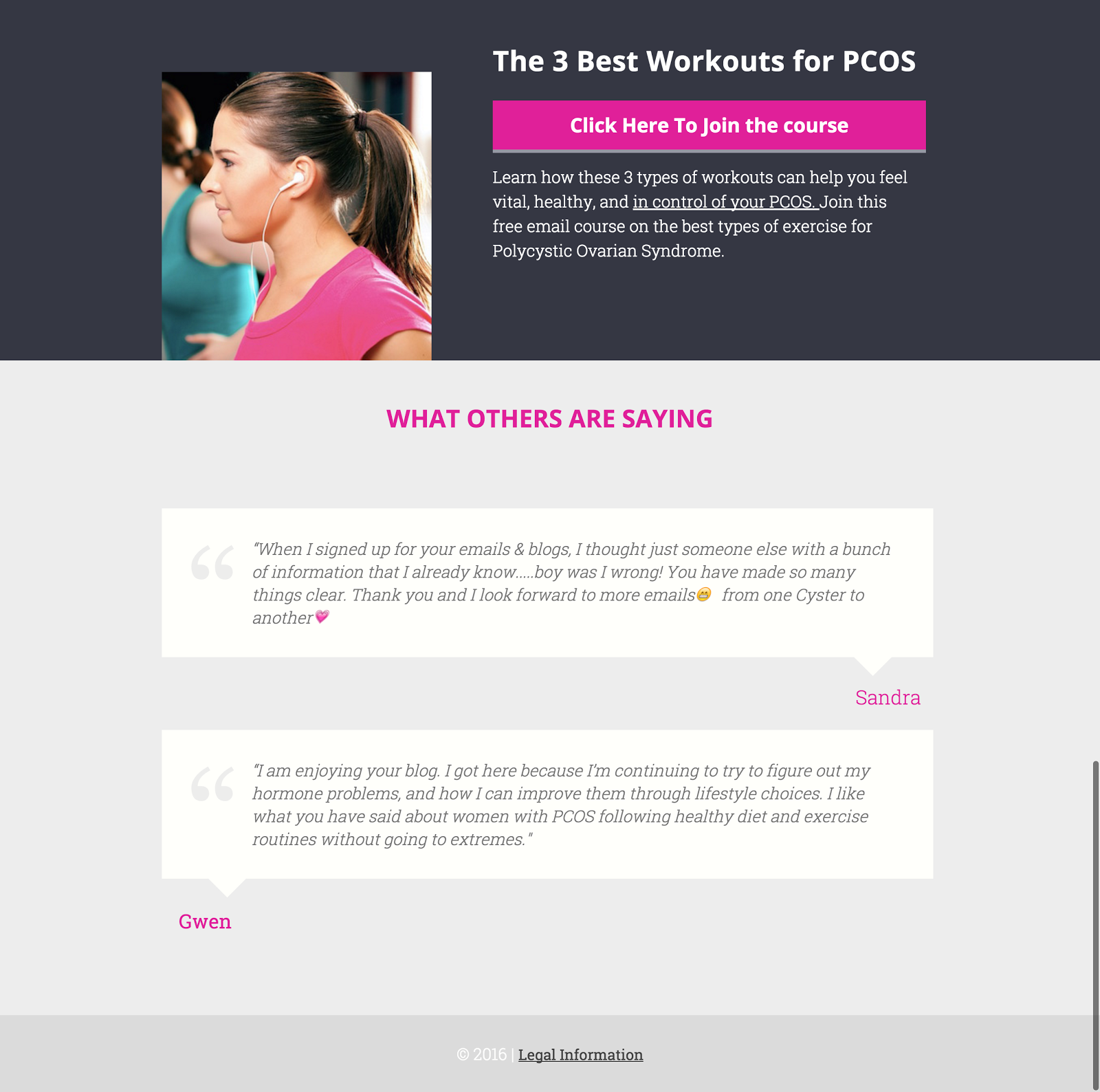
After converting, new subscribers receive a series of emails as part of a free email course.

What made Erika's campaign even more successful was that she generated revenue, in addition to new blog subscribers.
Here is how the Facebook ad campaign was (less than) free.
In emails 1, 4 and 6, of her eight email autoresponder, she mentions to the reader that she has some premium workout plans already made and points them to the link. She does it in a non-pushy way and doesn’t really “sell” it until email 6, after they’ve received nearly a week’s worth of value.
Let’s look more closely.
Email 1 – is a welcome email that gets sent immediately after opting in. She shows people her transformation, gets them pumped about the course and says the first lesson will come tomorrow.
But there are always some customers who, after they opt in or take any action with a company (purchase, etc.) are on a high and want more. She gives them a chance to do that here:
The video introduces her “Just Start” Workout program, which is a downloadable PDF and costs only $15.
Email 2 – 3 deliver straight value like I showed you above. They make no ask and the customer doesn’t hear about the premium workouts at all. These two emails cover the foundation of her PCOS workout strategy: strength conditioning and cardio.
Email 4 discusses active rest, and how you should orchestrate the week and fit in the workouts outlined in emails 2 and 3. So continuing on that theme, at the bottom of the email, Erika once again gently mentions that she has workouts that “put it all together”:
Email 5 adds more value with a discussion on belly fat – a key pain point of the customer.
Email 6 is the first “hard sell” email. At this point the customer has received almost a week’s worth of lessons with someone finally speaking to them about beating the disease that is affecting their entire life and that they think about every day.
Email 7 then talks about willpower and reminds them of the guide in the PS and Email 8 closes the course.
Overall she has sold $632 dollars of workout programs from the Facebook campaign, $140 more than the $492 she spent while collecting around 2000 email subscribers and over 11,000 unique visitors to her site.
"How I generated 2,178 subscribers in 14 days with a tiny $60 investment
by Kamila Gornia"
In this case study, Kamila uses Facebook ads to promote a contest and generate leads to her health blog (Sensual Appeal) for pennies each.
Take a look at her results and how well contests work for minimizing your cost-per-lead:
For this giveaway, I got a total of 2,178 contestants and a total of 7779 entries. People could get extra points for referring someone else to sign up for the giveaway as well so clearly plenty of people did that. That grew my list from a little over 1k to 3.3k in less than 16 days. Pretty impressive, right?
Cost per lead:
Now, we have to think about costs.. you might be thinking.. man, she had to spent a lot of money on advertising for this one, right? Not quite. In fact, I initially only spent $50 on a Facebook ad for this. Then I added $10 extra because I saw how effective it was and wanted to have it carry through till the end with a bang. That’s $60 total.
That comes out to paying a little over $0.02 per lead. Obviously, not every single person came directly from the ad but when you think about the monetary investment in this campaign, per lead… that’s literally what it comes out to.
WHEN HAVE YOU EVER PAID SO LITTLE PER LEAD?! Two freaking cents! Well, if you have, then awesome, kudos, but I haven’t so I was beyond happy.
Conclusion
The strategy of promoting a valuable offer on Facebook and directing prospects to a landing page has worked time and time again, across all industries. The key to successfully increasing your blog subscribers is executing on each step of the process.
- Make sure you're targeting your buyer personas
- Create a Lead Magnet with a specific purpose
- Build a landing page that closely mirrors your Facebook ad and Lead Magnet
- Optimize for conversions
Once you get the hang of it, creating effective Facebook campaigns isn't too difficult or time-consuming.
Featured Image Credit: Facebook.com


Order Your Copy of Marcus Sheridan's New Book — Endless Customers!


